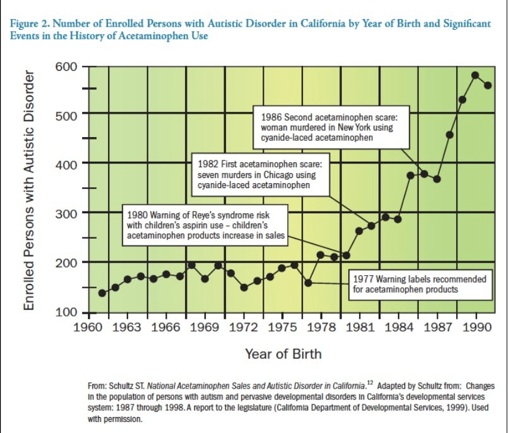By William Parker, Ph.D.
Duke University Medical Center
Special to SafeMinds
My research looks at what causes harmful inflammation in people in Western societies. The triggers of inflammation are recent developments in human history, appearing after the agricultural revolution only 10,000 years ago. Most did not appear until just a few decades ago, as we entered the post-industrial age. 1 My favorite example is the loss of biodiversity from the human body. Humans have always been bathed inside and out with bacteria, viruses, fungi, worms, and other organisms, but in recent decades our bodies’ ecosystems have become much less diverse, to our detriment.
Inflammation can be described simply as an aggressive immune response. It’s not a bad thing, and in fact is necessary under certain circumstances. However, inflammation in Western society has gotten out of control, resulting in pandemics of allergies, autoimmune conditions, and increased rates of cancer.
I’ll list the main factors known to cause inflammation in humans living in Western society.
These are the “big five”:
- Loss of biodiversity (biome depletion)
- Inflammatory diets
- Sedentary lifestyles
- Chronic psychological stress
- Vitamin D deficiency
Scientists hypothesize that if we could eliminate these five factors, we would virtually eliminate allergies and autoimmune disorders.2,3 We also think that the rate of cancer would drop profoundly 4,5].
Most importantly for this discussion, the rate of neuropsychiatric disorders is expected to plummet if we could control these five factors.6,7 The high rates of autism should drop dramatically.6, 7
People need to make drastic lifestyle changes. Those might not happen overnight. But, fortunately, sometimes there is another way to avoid an inflammatory disease. If we can identify a “trigger,” a necessary factor that interacts with inflammation to cause a specific disease, then we can avoid that specific disease. We can’t avoid ragweed pollen to avoid hay fever, and we can’t avoid food to avoid food allergies, but it looks like we may be in luck when it comes to avoiding autism. An apparent and easily avoidable trigger for autism has been found.
Steve Schultz is the scientist who identified what appears to be an important trigger for autism. He was a practicing dentist for 21 years before going back to school to earn a Ph.D. in an effort to determine why his son, Nathan, had regressed into autism. Based on his personal observations, Schultz at first thought that it was the MMR vaccine, but that had already been tested and it looked like a dead end. There was not going to be any way to get a Ph.D. working on that. However, as Schultz explained in his book, “Understanding Autism: My quest for Nathan”:
“Then I remembered that Nathan had gotten so sick from the MMR vaccine and how I had given him so much acetaminophen. Perhaps there was something about acetaminophen.”
Schultz was thinking about the acetaminophen. My first thought would be that this makes no sense. Why would one of the most commonly used drugs on the planet, known to fight inflammation, lead to an inflammatory disease such as autism? My second and third thoughts would be the same: Schultz’s thinking makes no sense. The presence of some sort of toxin might be the trigger, but acetaminophen?
But Schultz was running out of possible suspects.
With zero evidence, Schultz began to examine acetaminophen. As a detective investigates the last remaining suspect, Schultz started to work on acetaminophen not because he was suspicious of this much loved pain reliever, but because there was no other culprit to examine.
Quickly, he found plenty of reason to be suspicious.
Acetaminophen was the last remaining drug in a particular class of relatively toxic drugs that is derived from coal tar. It was, even at that time, the only drug left in its class not discontinued because of toxicity. It was already known to be associated with the development of asthma in children.8 Oddly enough, it was not known if acetaminophen actually worked to alleviate fever in children.9
Acetaminophen rapidly gained traction as a great suspect. First, Schultz found that the rise in autism corresponded to the rise in acetaminophen use. The first cases of autism happened around the time when coal-tar derived drugs, which give rise to acetaminophen upon metabolism, were introduced. Then Schultz did what is, in my view, a marvelous thing. He remembered two cases of deadly poisonings in which drugs containing acetaminophen were tampered with, first in 1982 and then in 1986. These two events caused temporary declines in the use of acetaminophen. Schultz’s initial test would be simple. If indeed acetaminophen was a possible culprit, then the steady, decades-long rise in autism should be punctuated by two brief periods of relief.
As Schultz explained:
“I saw that children born during both of these acetaminophen poisoning episodes were less likely to have autism. And I knew. Acetaminophen use was linked to the rise in autism rates.”
He went on to test this idea further. He performed and then published a retrospective survey in 2008.10 The results were clear:
“Children who used acetaminophen at age 12 to 18 months were more than eight times as likely to be in the autism group when all children were considered and more than 20 times as likely to be in the autism group when limiting cases to children with regression.”
There was no similar autism effect with ibuprofen. In fact, as Schultz explained to me recently by email, “I did not see a direct association with any of the vaccines themselves. It was only the combination of acetaminophen and the MMR vaccine which increased autism risk.”
Schultz had data that should have warned the world. The study pointed singularly at acetaminophen. Not a vaccine. A bad reaction to a vaccine plus ibuprofen was not associated with autism. A bad reaction to a vaccine plus acetaminophen was associated with autism.
Yet, the world didn’t seem to notice.
Parents were still grabbing Infants’ Tylenol and other popular brand-name, acetaminophen-containing medications targeted at children off of the shelf like hot-cakes.
Schultz’s study was small and it shouldn’t be the final word on the topic. It isn’t. A lot of information has accumulated since Schultz’s first published it seven years ago:
The same year that Schultz published his first work on the topic, a large, multinational study found a dose dependent association between use of acetaminophen and asthma, rhinoconjuctivitis, and eczema.11
A number of scientists have independently published molecular mechanisms by which acetaminophen can induce inflammation.12-15 The drug can profoundly alter toxin metabolism and inflammatory processes in the body. It actually makes sense that acetaminophen causes brain damage in some children. In fact, based on how the drug affects the body, it would be surprising if the drug didn’t put a baby’s developing brain at risk.
A very large study in Norway showed that the use of acetaminophen by mothers during pregnancy was associated with developmental problems in children at three years of age.16 Children had problems with their emotions, aggression, attention, and gross motor skills. Ibuprofen use was not associated with these problems.
A study at UCLA in collaboration with scientists in Denmark and Taiwan found that use of acetaminophen during pregnancy is associated with attention deficit hyperactivity disorder.17 To quote the authors, “Results did not appear to be confounded by maternal inflammation, infection during pregnancy, the mother’s mental health problems, or other (variables they examined)”.
An interesting epidemiologic study suggested that use of acetaminophen at the time of circumcision might account for many cases of autism.18 Since many parents are unaware of acetaminophen use following circumcision, an epidemiologic study may be the best tool to examine this issue.Yet, to this day, a definitive study has never been conducted to see if acetaminophen works better than traditional methods of cooling down the body (e.g., using a cool towel) to relieve fever. Parents still believe it’s a safe and effective medication for children. Marketing and the herd mentality, rather than scientific evidence, still dictate behavior, even for medical professionals recommending the drug.Maybe in the future, what we now call autism will be a condition of historical interest known as “acetaminophen-induced neurodevelopmental disorder.”Just maybe. Nobody can know for sure.What we do know is that acetaminophen is bad for a fetus and bad for a baby.
In the meantime, what should parents do?
- Don’t give any acetaminophen-containing medication to your child or take it while pregnant. Seek a physician’s help if your child is ill, and keep in mind the fact that we tend to overmedicate. Somehow our society has become convinced that chemicals which alter brain function are generally good for babies. This is almost certainly a tragic error. For example, a report on WebMD, co-authored by a representative from the pharmaceutical industry, states that over-the-counter cold products should never be used on children under 4 years old.
- Check every label: Acetaminophen is found in literally hundreds of drugs. One list can be found here. Acetaminophen is known by other names (paracetamol and paracetamolo) in other countries. Education and awareness are the keys.
- Don’t let medical personnel administer the drug to your child. It is the go-to drug for many things, from circumcision to vaccination, in many clinics and hospitals around the world.
- Be proactive and spread the word. Share this information with people you know. I find that people with grown children, with future grandbabies on their mind, are particularly interested. Post a link to this article on Facebook. Tweet it to your friends. Print it out and hand it to your child’s doctor. Given the available data, you might be able to prevent a case of autism simply by letting a hundred people know about the connection between acetaminophen and brain injury to children.
 HOW SAFEMINDS IS HELPING
HOW SAFEMINDS IS HELPING
SafeMinds has funded Dr. Parker’s work and prepares informational blogs to help parents and self-advocates utilize the science for their own treatment strategies. You can help us continue our work by donating to our Making a Difference Research Fund or our Parent and Family Education Fund, or by contacting us to volunteer.
 William Parker began his research career as an undergraduate in the mid-1980s studying immunology and biochemistry. He earned his Ph.D. in chemistry in 1992, studying the biophysical properties of biological macromolecules. Since then, his research has focused on how our immune system functions in the Western world to cause inflammation. He is best known for discovering the function of the human vermiform appendix, answering a 400-year-old question first posed by Leonardo da Vinci. His most recent work probing the role of helminths in normal immune function has led to new and more feasible approaches to helminthic therapy as well as the view that helminthic therapy may help treat a wide range of neuropsychiatric disorders. Much of William’s current work involves how increasing biodiversity with helminths protects the brain, both during development19 and in adulthood.20 It works. As a scientist, William is impartial about acetaminophen. He is not the one who identified it as a trigger for autism. In fact, identification of acetaminophen as a trigger for autism means that his work on biome depletion and restoration can be ignored when developing a plan to prevent autism. You don’t need a helminth to prevent autism. Thankfully!
William Parker began his research career as an undergraduate in the mid-1980s studying immunology and biochemistry. He earned his Ph.D. in chemistry in 1992, studying the biophysical properties of biological macromolecules. Since then, his research has focused on how our immune system functions in the Western world to cause inflammation. He is best known for discovering the function of the human vermiform appendix, answering a 400-year-old question first posed by Leonardo da Vinci. His most recent work probing the role of helminths in normal immune function has led to new and more feasible approaches to helminthic therapy as well as the view that helminthic therapy may help treat a wide range of neuropsychiatric disorders. Much of William’s current work involves how increasing biodiversity with helminths protects the brain, both during development19 and in adulthood.20 It works. As a scientist, William is impartial about acetaminophen. He is not the one who identified it as a trigger for autism. In fact, identification of acetaminophen as a trigger for autism means that his work on biome depletion and restoration can be ignored when developing a plan to prevent autism. You don’t need a helminth to prevent autism. Thankfully!
References
- Bilbo, S.D., et al., Reconstitution of the human biome as the most reasonable solution for epidemics of allergic and autoimmune diseases. Medical Hypotheses, 2011. 77(4): p. 494-504.
- Parker, W. and J. Ollerton, Evolutionary biology and anthropology suggest biome reconstitution as a necessary approach toward dealing with immune disorders. Evolution, Medicine, and Public Health, 2013. 2013: p. 89–103.
- Parker, W., et al., A prescription for clinical immunology: the pills are available and ready for testing. Current Medical Research and Opinion, 2012. 28: p. 1193-1202.
- Rook, G.A.W., Review series on helminths, immune modulation and the hygiene hypothesis: the broader implications of the hygiene hypothesis. Immunology, 2009. 126(1): p. 3-11.
- Fox, J.G., et al., Concurrent enteric helminth infection modulates inflammation and gastric immune responses and reduces helicobacter-induced gastric atrophy. Nature medicine, 2000. 6(5): p. 536-42.
- Bilbo, S.D., J.P. Jones, and W. Parker, Is autism a member of a family of diseases resulting from genetic/cultural mismatches? Implications for treatment and prevention. Autism Research and Treatment, 2012. 2012: p. 1-11.
- Bilbo, S.D., C.D. Nevison, and W. Parker, A model for the induction of autism in the ecosystem of the human body: the anatomy of a modern pandemic? Microb Ecol Health Dis, 2015. 26: p. 26253.
- Shaheen, S.O., et al., Frequent paracetamol use and asthma in adults. Thorax, 2000. 55(4): p. 266-70.
- Meremikwu, M. and A. Oyo-Ita, Paracetamol for treating fever in children. Cochrane Database of Systematic Reviews, 2002(2): p. CD003676.
- Schultz, S.T., et al., Acetaminophen (paracetamol) use, measles-mumps-rubella vaccination, and autistic disorder. The results of a parent survey. Autism, 2008. 12(3): p. 293-307.
- Beasley, R., et al., Association between paracetamol use in infancy and childhood, and risk of asthma, rhinoconjunctivitis, and eczema in children aged 6-7 years: analysis from Phase Three of the ISAAC programme. Lancet, 2008. 372(9643): p. 1039-48.
- Becker, K.G. and S.T. Schultz, Similarities in features of autism and asthma and a possible link to acetaminophen use. Medical Hypotheses, 2010. 74(1): p. 7-11.
- Schultz, S.T., Can autism be triggered by acetaminophen activation of the endocannabinoid system? Acta Neurobiologiae Experimentalis (Warsaw), 2010. 70(2): p. 227-231.
- Good, P., Did acetaminophen provoke the autism epidemic? Alternative Medicine Review, 2009. 14(4): p. 364-372.
- Shaw, W., Evidence that Increased Acetaminophen use in Genetically Vulnerable Children Appears to be a Major Cause of the Epidemics of Autism, Attention Deficit with Hyperactivity, and Asthma. Journal of Restorative Medicine, 2013. 2: p. 1-16.
- Brandlistuen, R.E., et al., Prenatal paracetamol exposure and child neurodevelopment: a sibling-controlled cohort study. International Journal of Epidemiology, 2013. 42(6): p. 1702-1713.
- Liew, Z., et al., Acetaminophen use during pregnancy, behavioral problems, and hyperkinetic disorders. JAMA Pediatr, 2014. 168(4): p. 313-20.
- Bauer, A. and D. Kriebel, Prenatal and perinatal analgesic exposure and autism: an ecological link. Environmental Health, 2013. 12(1): p. 41.
- Williamson, L.L., et al., Got worms? Perinatal exposure to helminths prevents persistent immune sensitization and cognitive dysfunction induced by early-life infection. Brain, Behavior, and Immunity.
- Cheng, A.M., et al., Overcoming evolutionary mismatch by self-treatment with helminths: current practices and experience. Journal of Evolutionary Medicine, 2015. 3: p. Article ID 235910.



